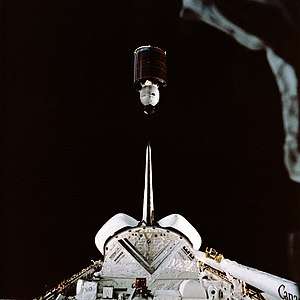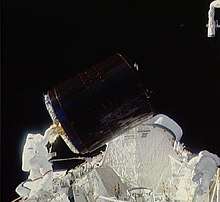Palapa
Palapa is a series of communication satellites owned by Indosat Ooredoo, an Indonesian telecommunications company which is a subsidiary of its namesake Ooredoo. All the satellites were launched by the United States, starting with the first in July 1976, at which time Indonesia became the first developing country to operate its own domestic satellite system.[1] The estimated cost for the project was $1 billion.[2]

Name
The name "Palapa" was bestowed by then Indonesian President Suharto, after the Palapa oath sworn by Gajah Mada, the Prime Minister of Majapahit Kingdom, in 1334.[3] According to the Pararaton (Book of Kings), Gajah Mada swore that he would not taste any palapa (historians suggest it refers to spice or a kind of flavouring), as long as he had not succeeded in unifying Nusantara (the Indonesian archipelago).[1] After watching the launching process of the satellite via television in Jakarta, President Suharto revealed his reason on naming the satellite "palapa"; to show that Indonesia had a glorious past, and also hope that the system can unite the archipelago.[3]
History

The first satellite, Palapa-A1 of 300 kg, was launched on 8 July 1976 at 23:31 UTC from Kennedy Space Center by a Delta rocket, or at 06:31 Western Indonesian Time on 9 July 1976.[3]
Palapa B2 was launched from STS-41-B on 3 February 1984, to be put into service afterward, but the perigee kick motor (also known as the Payload Assist Module, or PAM) on the satellite failed during its approach to geosynchronous orbit, placing it at an improper and inoperable low Earth orbit. It was retrieved on 16 November 1984, by the STS-51-A mission of NASA's Space Shuttle, where it was brought back to earth. The Space Shuttle mission to retrieve Palapa B2 as well as the Westar 6 satellite which shared the launch payload with Palapa B2, was partially funded by the insurance companies led by Lloyd's of London who insured the launch of those two satellites.[4]
Series D
The Palapa D satellite was manufactured by Thales Alenia Space and launched aboard a Chinese Long March 3B rocket on 31 August 2009. However, it failed to reach the intended orbit following a failure of the third stage of the rocket to reignite as planned. Thanks to SpaceBus platform efficiency, the satellite was recovered and maneuvered into the correct geosynchronous orbit by September 2009, but this left it with only enough fuel for 10 years in orbit, a third less than contracted.[5] This US$200 million satellite has more transponders than its predecessors (40 transponders, C2 only has 36). 40% of its transponders will be used by Indosat for their own purposes while the other 60% will be rented to others.
Indosat will use Palapa D for its broadband internet service (IM2) with Ku-band technology (12/14 GHz). In 2006, their total income increased by about 12.3%. With the new satellite coming up, the company hopes to earn more profits from the multimedia, internet, and communication businesses.[6]
At the end of October 2009, Palapa D started its airing operations. Only a few channels have been replaced, yet many are awaiting 11 November 2009 for the start of Palapa D's full operation. As of its release, the TV channels on Palapa C2 that have been relocated are; MINANG TV, RCTI, SCTV, Global TV, METRO TV, TVRI, NHK, Almanhar TV and Spacetoon. Some radio channels have also surfaced which have been included from Satellindo's system.
Palapa D is currently running well with plans to include a new cable TV channel through the Ku-band of the satellite which is planned to include High Definition channels. New channels have also been added and replaced as of May 2010. GlobalTV was replaced by Lejel, a home shopping channel. After the insertion of Lejel TV, Global TV received its own transponder. Recent rumors states that KBS World Indonesia will renew its position in the satellite by transferring to a horizontal transponder.
Lighthouse Project
The Palapa project was one of the Lighthouse projects instituted during the New Order period to build national pride. Other lighthouse projects during the New Order included transport infrastructure, the Taman Mini Indonesia Indah park and the national aircraft company. Most of these involved extravagant inauguration ceremonies with the officials who oversaw the projects in the spotlight. In the inauguration ceremony of the Palapa satellite system, President Suharto used a switch with 17 jewels (17 is the date of Indonesia's Proclamation of Independence) in the shape of a traditional dagger or kris. Besides symbolizing national unity and concretely helping unite the country as the satellite served its purpose as communication infrastructure, the satellite also tied advanced technology to Javanese tradition as epitomized by the inauguration ceremony.[7]
References
- "History of Palapa Satellite". Indosat. Archived from the original on 29 April 2015. Retrieved 14 April 2015.
- Jones, R. (1976). "Satellite communications: Indonesia's bitter fruit". Pacific Research and World Empire Telegram. 7 (4): 1–6.
- "Planning and Development of Indonesia's Domestic Communications Satellite System PALAPA". Online Journal of Space Communication. Society for Satellite Professionals International (SSPI). Retrieved 14 April 2015.
- "Seven Things You Might Not Know You Can Insure" (Web). The One Brief, Aon. Retrieved 19 October 2017.
- "Indonesian Satellite Reaches Preset Orbit Despite Skewed Launch". Spacemart.com. 14 September 2009. Retrieved 14 September 2009.
- Thales Alenia Space Press release Archived 2007-07-03 at the Wayback Machine
- Barker, Joshua (December 2005). "Engineers and Political Dreams: Indonesia in the Satellite Age". Current Anthropology. 46 (5): 703–727. doi:10.1086/432652.
External links
- Gunter's Space Page - information on Palapa
- Palapa A at Boeing Palapa-A
- Palapa C2 at Lyngsat
- Palapa D at Lyngsat